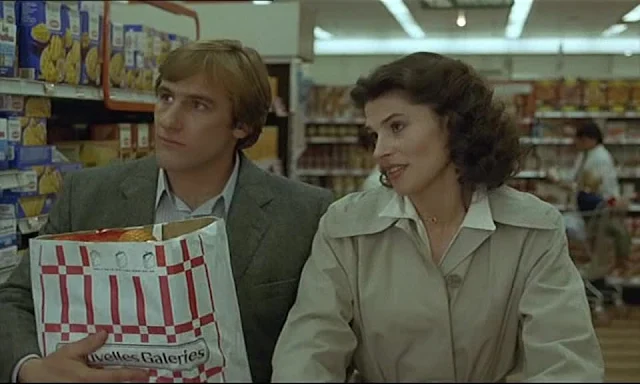 |
| James Mason and Christopher Olsen in Bigger Than Life |
Ed Avery: James Mason
Lou Avery: Barbara Rush
Richie Avery: Christopher Olsen
Wally Gibbs: Walter Matthau
Dr. Norton: Robert F. Simon
Dr. Ruric: Roland Winters
Bob LaPorte: Rusty Lane
Director: Nicholas Ray
Screenplay: Cyril Hume, Richard Maibaum
Based on a magazine article by Berton Roueche
Cinematography: Joseph MacDonald
Music: David Raksin
Making a domestic drama like
Bigger Than Life in CinemaScope is a bit like sending a love letter in a business envelope: The carrier feels wrong for the message. And yet, Nicholas Ray makes it work, partly by acknowledging the irony and playing with it. CinemaScope's outlandish dimensions were designed to put up a fight against the tiny TV screens of the day, which were rapidly becoming the venue for domestic dramas and situation comedies focusing on everyday family life. So Ray makes
Bigger Than Life into a kind of companion piece for his
Rebel Without a Cause (1955): Both films are antithetical to the portraits of 1950s families on shows like
Father Knows Best and
Leave It to Beaver.* Ray also uses CinemaScope for shock value. The wide screen was designed to provide almost more information than the viewer could process. It's hard to hide things from a viewer if the screen is testing the limits of peripheral vision, but Ray and cinematographer Joseph MacDonald manage it beautifully in the scene in which young Richie Avery frantically hunts through his father's things for the medicine that is causing his father's psychotic behavior. Finally he locates the pills, hidden behind the drawer underneath a mirror on top of a dresser, but as he shoves the drawer back in, the mirror changes angles to reveal his father's face behind him. Although the scene would have worked in a standard format, the wide screen heightens the surprise by almost lulling us into thinking that we could see everything in the room.
Bigger Than Life was a flop in its day, despite its ripped-from-the-headlines premise -- Miracle Drug May Be Driving You Crazy -- and one of James Mason's best performances. It may have failed because audiences weren't ready for a portrait of the dark side of American family life that wasn't based, like
Rebel Without a Cause, on "juvenile delinquency" or, like
Peyton Place (Mark Robson, 1957), on sex.
Bigger Than Life suggested that we shouldn't trust those we were most inclined to trust: doctors and pharmacology. The physicians in the film are cold, gray men with no bedside manner, stonewalling questions from the patient's wife and imperiously clinging to their expertise. The film also gives us a rather chilling portrayal of conventional attitudes toward mental illness, a stigma far worse than any physical disorder. Ed's wife, Lou, resists the idea that her husband might be psychotic simply because it might endanger his job. Barbara Rush gives a capable performance, most effectively when she snaps under the constant pressure and smashes a bathroom mirror, but the role really needed an actress of more consistent depth and range, someone like Jean Simmons for example, so that Lou doesn't just stand around prettily fretting so much. There are also some nice touches in the otherwise conventional pretty suburban decor of the Averys' house, such as the corroded old water heater in the kitchen, a persistent symbol of the precariousness of the family finances, and the rather dark travel posters of Rome and Bologna that hint at a desire to escape. The "hopeful" ending is also nicely ambiguous.
*The Beaver himself, Jerry Mathers, has a blink-and-you'll-miss-it walk-on bit as one of the schoolkids in
Bigger Than Life.
Watched on Turner Classic Movies









